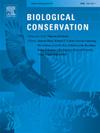50年来大西洋荒原区域尺度的植被变化
IF 4.4
1区 环境科学与生态学
Q1 BIODIVERSITY CONSERVATION
引用次数: 0
摘要
希思兰是欧洲高度保护的半自然栖息地。armoramerican Massif(法国西北部)是荒原保护的主要地区,尽管在上个世纪它们急剧减少。为了了解近50年来该地区石南植物群落的变化程度,我们对1947年至1992年的444个植被样地进行了重新调查。在确定了历史和当前生境类型的质变后,分析了反映物种多样性、特定物种(典型石楠地物种、昆虫传粉物种、稀有物种)存在或丰度以及生态条件Ellenberg指标的各种植物群落参数的响应。我们还确定了这些参数的响应是否取决于沿海或内陆地区,或受保护或不受保护地区的位置。几乎一半(46%)的最典型的历史石南荒原(即开放的白垩系植被)现在被毛蕊草和蕨类植物占主导地位,或者已经进化成木林植被。对所有群落参数的响应表明石楠荒原生境正在退化。在物种丰富度和昆虫传粉植物物种丰富度方面,内陆的下降比沿海的明显。此外,我们的研究结果表明,保护区的指定并没有阻止荒原的退化。通过确定过去50年在区域层面上发生的变化,我们的结果强调了通过采用适当的管理方法保护最后剩余的荒原的重要性。本文章由计算机程序翻译,如有差异,请以英文原文为准。
Fifty years of regional-scale vegetation change on Atlantic heathlands
Heathlands are semi-natural habitats of high conservation interest in Europe. The Armorican Massif (north-west of France) is a prime area for heathlands conservation, although they have declined sharply during the last century. In order to understand the extent of the changes in heathland plant communities over the last 50 years in this region, we carried out a resurvey of 444 vegetation plots historically sampled between 1947 and 1992. After identifying the qualitative changes in habitat types between the historical and current periods, we analysed the response of various plant community parameters reflecting species diversity, the presence or abundance of particular species (typical heathland species, insect-pollinated species, rare species), and Ellenberg indicators of ecological conditions. We also determined whether the responses of these parameters depended on the location in coastal or inland areas, or in protected or unprotected areas. Almost half (46 %) of the most typical historic heathlands (i.e. open ericaceous vegetations) is now dominated by Molinia and bracken or has evolved into wooded vegetations. Responses for all community parameters indicate a heathland habitat degradation. For species richness and insect-pollinated plant species richness, this decline was more pronounced for inland than coastal heathlands. Also, our results show that the designation of sites as protected areas has not prevented heathland degradation. By identifying the changes that have taken place over the last 50 years at regional level, our results highlight the importance of conserving the last remaining heathlands by applying appropriate management methods.
求助全文
通过发布文献求助,成功后即可免费获取论文全文。
去求助
来源期刊

Biological Conservation
环境科学-环境科学
CiteScore
10.20
自引率
3.40%
发文量
295
审稿时长
61 days
期刊介绍:
Biological Conservation is an international leading journal in the discipline of conservation biology. The journal publishes articles spanning a diverse range of fields that contribute to the biological, sociological, and economic dimensions of conservation and natural resource management. The primary aim of Biological Conservation is the publication of high-quality papers that advance the science and practice of conservation, or which demonstrate the application of conservation principles for natural resource management and policy. Therefore it will be of interest to a broad international readership.
 求助内容:
求助内容: 应助结果提醒方式:
应助结果提醒方式:


